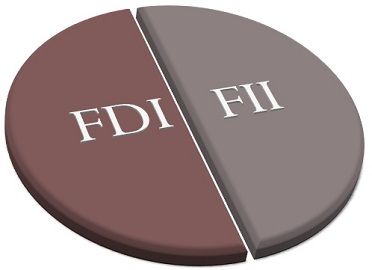 Foreign Direct Investment (FDI) is defined as the type of investment into production or business in a country, by an enterprise based in another country. It is often contrasted with Foreign Institutional Investment (FII), which is an investment fund, based in the country, other than the country, in which investment is made.
Foreign Direct Investment (FDI) is defined as the type of investment into production or business in a country, by an enterprise based in another country. It is often contrasted with Foreign Institutional Investment (FII), which is an investment fund, based in the country, other than the country, in which investment is made.
Both are the forms of investment made in a foreign country. FDI is made to acquire controlling ownership in an enterprise but FII tends to invest in the foreign financial market. In most cases, the former is given preference over the latter because it benefits the whole economy.
There are stark differences between FDI and FII which have been presented in this article excerpt.
Content: FDI Vs FII
Comparison Chart
| Basis for Comparison | FDI | FII |
|---|---|---|
| Meaning | When a company situated in one country makes an investment in a company situated abroad, it is known as FDI. | FII is when foreign companies make investments in the stock market of a country. |
| Entry and Exit | Difficult | Easy |
| What it brings? | Long term capital | Long/Short term capital |
| Transfer of | Funds, resources, technology, strategies, know-how etc. | Funds only. |
| Economic Growth | Yes | No |
| Consequences | Increase in country's Gross Domestic Product (GDP). | Increase in capital of the country. |
| Target | Specific Company | No such target, investment flows into the financial market. |
| Control over a company | Yes | No |
Definition of FDI
Foreign Direct Investment shortly known as FDI refers to the investment in which foreign funds are brought into a company based in a different country from the investor company’s country. In general, the investment is made to gain a long lasting interest in the investee enterprise. It is termed as a direct investment because the investor company looks for a substantial amount of management control or influence over the foreign company.
FDI is the considered as one of the primary means of acquiring external assistance. The countries where the availability of finance is quite low can get finance from developed countries having the good financial condition. There are a number of ways through which a foreign investor can get controlling ownership like by way of merger or acquisition, by purchasing shares, by participating in a joint venture or by incorporating a wholly owned subsidiary.
Definition of FII
FII is an abbreviation used for Foreign Institutional Investor, are the investors that pool their money to invest in the assets of the country situated abroad. It is a tool for making quick money for the investors. Institutional investors are companies that invest money in the financial markets in the country based outside the investor country. It needs to get itself registered with the securities exchange board of the respective country for making the investment. It includes banks, mutual funds, insurance companies, hedge funds, etc.
FII plays a very crucial role in any country’s economy. Market trend moves upward when any foreign company invests or buys securities, and similarly, it goes down if it withdraws the investment made by it.
Key Differences Between FDI and FII
The significant differences between FDI and FII are explained below:
- Foreign Direct Investment or FDI is defined as the investment made by a company in the company situated outside the country. Foreign Institutional Investor or FII is when investors, most commonly in the form of institutions that invest in the country’s financial market.
- FII is a way to to make quick money, the entry and exit to the stock market are very easy. On the other hand, the entry and exit are not easy in FDI.
- FDI brings long-term capital in the investee company whereas FII may bring long or short term capital in the country.
- In the case of FDI, there is the transfer of funds, resources, technology, strategies, know-how. Conversely, FII involves the transfer of funds only.
- FDI increases job opportunities, infrastructural development in the investee country and thus leads to economic growth, which is not in the case of FII.
- FDI results in the increase in the country’s productivity. As opposed to FII that results in the increase in the country’s capital.
- FDI targets a particular company, but FII does not target a particular company.
- FDI obtains management control in the company. However, FII does not enable such control.
Conclusion
After the above discussion, it is quite clear that the two forms of foreign investment are completely different. Both have its positive and negative aspects. However, foreign investment in the form of FDI is considered better than FII because it does not just bring capital but also amounts to better management, governance, transfer of technology and creates employment opportunities.






jiban sharma says
This is very helpful for the students of economics.
Thanks
pi says
Thanks
Sophia Britt says
This is undoubtedly the best thing that I’ve come across today in the internet. It was a long time that I have been thinking on this topic but I couldn’t satiate my quench for knowledge through any post that I read. However, today that I came across your article, I seem to have learnt a lot and I have also gained enough knowledge on this topic. Thanks once again.
Nadzeen Shahana says
thanks for this elaborate answer .